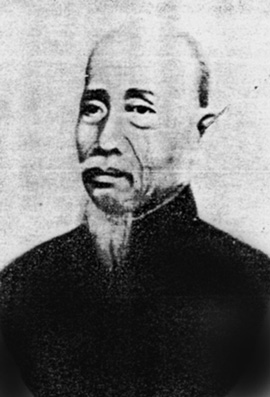
CHAN HEUNG
1805 - 1881
 |
CHAN HEUNG 1805 - 1881 |
|
home | instructors
| choy lay fut | ving
tsun | curriculum | news
| gallery | supplies
| links | contact
|
|
Born in 1805, Chan Heung began his martial arts training at the age of seven under his uncle Chan Yuen Woo. Chan Yuen Woo was a Shaolin disciple and a student of the martial monk, Dok Jung. Dok Jung was a practitioner of the Fut Gar method (a predecessor to the Hop Gar style). At the age of nineteen, Chan Heung began his training with a classmate of his uncle, Lee Yau Shan, who himself was also a student of Jee Shim. When Chan Heung turned twenty-five, Lee Yau Shan introduced him to a Shaolin refugee named Choy Fook. Choy Fook was nicknamed Lantau Fook (or “broken head” Fook) as his head was terribly scarred during the burning of the Shaolin temple by the Qing troops. Chan Heung would later name his fighting method Choy Lay Fut to honor his teachers. Choy was for Choy Fook, Lee (or Lay) was for Lee Yau Shan, and Fut (which meant Buddha in Chinese) was for the method taught to him by his uncle (and to honor Choy Lay Fut’s Buddhist origins). When he left Choy Fook after ten years of study, Chan Heung was asked by his master to call his style Hung Sing. Chan Heung obeyed his master’s wishes when he relocated to Sunwui Village to establish a school by that name (as he had not yet fully consolidated his knowledge to create Choy Lay Fut). Soon after his move to Sunwui, Chan Heung collaborated with the Heaven and Earth Society (whom the British dubbed the “Triads”) to secretly engage in anti-government activities. It was during this period that Chan Heung began to conceive Choy Lay Fut through the amalgamation of what he had learned from his three teachers. In 1853, together with his elder martial arts brother, Chan Chung Lin, Chan Heung teamed up with the Heaven and Earth Society and the Tai Ping Troops to attack Qing soldiers in Canton. The subsequent attack launched by Chan Heung and his comrades ended in tragedy. After suffering a defeat that cost the life of his kung fu brother, Chan Heung fled to Southeast Asia (near Malaysia) in an attempt to avoid further political strife. During his stay in Southeast Asia, Chan Heung once again opened a school to teach Hung Sing Choy Lay Fut. During the gold rush of the mid 1800’s, many Chinese immigrated to California in search of riches. Soon the Chinese community living abroad congregated to create the first Chinatown. A western strongman and boxer by the name of Gillis would enter the newly established Chinatown bully and harrass the local inhabitants. Though they tried, none could rid the community of this man. Upon hearing of Chan Heung’s exploits, the Chinese Consolidated Benevolent Association or the CCBA (established to consolidate and protect the interest of the Chinese living outside of their homeland) hired Chan Heung to appear in California to challenge this Gillis. Upon hearing of his countrymen’s plight, Chan Heung was angered to the point of thrusting a chopstick through a table during a meeting with the CCBA. Records of this meeting and the table with the chopstick hole is said to still exist within the CCBA headquarters. Chan Heung answered the CCBA’s plea and traveled to California to meet Gillis in an attempt to persuade him to stop his abuse on the Chinese. Gillis refused and presented a challenge to Chan Heung. Chan Heung had little trouble dispensing Gillis. Out of pity for his downed opponent, Chan Heung tended to Gillis’s injuries. Gillis thus agreed to bother the Chinese no longer. After the match, Chan Heung would stay in California for a few years to teach kung fu and medicine before returning to his students in Southeast Asia. After staying in Southeast Asia for a few more years, Chan Heung made his move to Hong Kong. During his stay in Hong Kong, he taught numerous students; of most the renown were Cheung Yim and Lung Gee Choy. When the government lifted the bounty on Chan Heung’s head, he made his moved back to his home village in China. When he returned to his village, Chan Heung focused his teachings to his children and those living in his village. Now older and with more combat experience, Chan Heung further consolidated his knowledge to formulate a progressive level system by dividing the Choy Lay Fut method into beginner, intermediate and advance stages. He then spent his time recording his discoveries and knowledge onto paper. Thus the curriculum of his earlier students and later students was understandably dissimilar. Please see the Choy Lay Fut history section for more details. |
|
home | instructors
| choy lay fut | ving
tsun | curriculum | news
| gallery | supplies
| links | contact
|
| © 2001 Philip Ng and Sam Ng. All rights reserved. |
| Website maintained by Studio Straightblast5 |